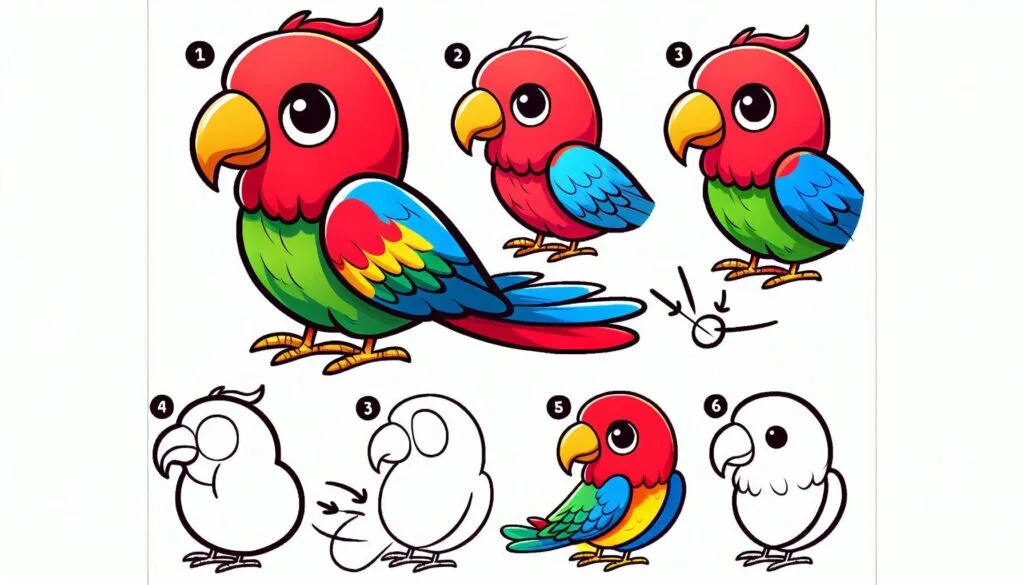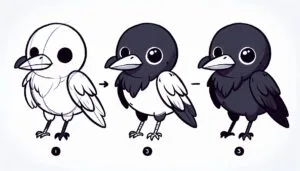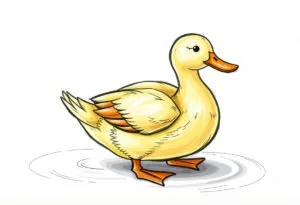Creating a parrot drawing can be a thrilling way to capture the vivid beauty of one of nature’s most vibrant and animated creatures. Parrots are famous for their vibrant feathers, curved beaks, and captivating eyes. In this guide, we’ll walk you through the process of drawing a parrot, paying close attention to its distinct characteristics and incorporating creative elements. Let’s begin on this vibrant journey!
The Distinctive Characteristics of Parrots
Parrots are well-known for their vibrant, multi-colored plumage, curved beaks, and robust, nimble physiques. Their silhouette is quite unique, featuring a lengthy tail, sturdy legs, and a noticeable beak. Understanding these features will enable you to create a more precise and lively portrayal of a parrot.
The Joy of Capturing Vibrant Feathers
The colorful plumage of a parrot presents an enjoyable challenge for your artwork. Creating a vibrant and visually appealing appearance requires using a range of colors and techniques to achieve a lifelike and attention-grabbing result. This challenge helps to improve your skills in using colors and rendering textures in your artwork.
Discovering the Fascinating World of Parrots Through Art
Parrots are captivating creatures with a wide range of behaviors and cultural importance. Exploring the fascinating world of these creatures allows us to appreciate their unique adaptations and understand their important roles in different ecosystems, as well as in our hearts as cherished companions. This theme highlights the educational element of art and the chance to explore different aspects of parrot life through creative expression.
Steps: How to Draw a Colorful Bird
First, start by drawing the basic shape.
Begin by sketching the fundamental outline of the parrot’s body. Start with a rounded oval or a slightly curved shape for the body. Create a smaller circle or oval at one end of the body to represent the head. Parrots have a compact body, so it’s important to ensure that it’s proportionate.
Next, we can move on to the second step, which involves adding the head and beak.
Place the head in the front of the body. The head should have a rounded shape and a noticeable, curved beak. Create the beak with a curved shape that extends from the head. Place two small, circular eyes on each side of the head. Parrots have captivating eyes, so consider making them slightly larger and more intricate.
Step 3: Illustrate the wings
Parrots possess wide, curved wings. Illustrate the wings expanding outwards from the body. Begin by drawing a gently curved line for the upper part of the wing, then add another curved line beneath it to create the wing’s shape. Use overlapping lines to create a textured effect when drawing the wing feathers. The feathers should have a longer and layered appearance.
Step 4: Sketch out the legs and feet
Parrots possess powerful, nimble legs adorned with razor-sharp talons. Extend the legs downward from the body. The legs should be strong and have a subtle curve. Include the feet by sketching two extended, curved lines that terminate in pointed claws. It’s important to ensure that the feet are securely placed on a perch or branch, especially if you have little ones with you.
Step 5: Incorporate the Tail
Extend the tail from the back of the body. The tail should have a lengthy and gently narrowing shape, with a wide foundation. Utilize a sequence of intersecting lines to depict the plumage of the tail. Ensure that the tail feathers have a sleek and fanned out appearance.
Step 6: Enhance the visual appeal and add a touch of elegance with texture and feathers.
To capture the texture of the parrot’s feathers, create a series of short, overlapping lines across the body and wings. Parrots have colorful and textured feathers, so use a combination of curved and straight lines to depict their appearance. Take note of the feather patterns on the wings and tail to enhance the realism and add visual interest.
Step 7: Perfecting the Form
Consider using a darker writing utensil to carefully trace over your initial sketch and enhance the parrot’s shape. Refine the contours of the body, head, wings, and tail. Make sure the body segments, legs, and wings are clearly defined and in the right proportions. Remove any unnecessary guidelines or overlapping lines to tidy up your drawing.
Step 8: Enhance with Vibrant Hues and Subtle Shadows
Bring your drawing to life with the addition of vibrant colors that will make the parrot’s plumage stand out. Opt for vibrant hues such as green, red, blue, and yellow to capture the essence of the parrot’s beautiful plumage. Enhance the artwork by incorporating shading to bring out the intricate details and add dimension to the feathers. Opt for lighter shades to enhance highlights and darker colors to add depth and dimension, resulting in a realistic and lifelike appearance.
Topic 1: The Distinctive Characteristics of Parrots
Exploring the unique features of a parrot through drawing allows you to appreciate its vibrant plumage, curved beak, and expressive eyes. Understanding these features enables you to create a comprehensive and precise portrayal. Understanding the intricacies of parrot anatomy can greatly improve your artistic abilities and deepen your understanding of these vibrant creatures.
Theme 2: The Joy of Capturing Vibrant Feathers
The vibrant plumage of the parrot presents an enjoyable and fulfilling endeavor for artists. Capturing the lively and energetic essence of young ones requires a combination of creativity and expertise. Experience the joy of creating a vibrant and detailed parrot’s plumage.
Theme 3: Discovering the Fascinating World of Parrots Through Art
Parrots provide a captivating opportunity to delve into intriguing aspects of bird life, thanks to their captivating appearance and cultural significance. Exploring different colors and textures in your artwork can create a visually captivating and educational experience. This theme emphasizes the excitement of exploring different aspects of parrot life through art.
In summary
Drawing a parrot can be a captivating and engaging experience that allows you to capture the vibrant features and textures of this beautiful bird. By following the steps in this guide and paying close attention to its anatomy, colors, and details, you can create a captivating and realistic parrot drawing. Embrace the joy of creating and let your imagination soar as you bring this magnificent creature to life on paper!


Check out this super fun and simple guide to learn how to draw a hummingbird with easy step-by-step instructions! This fun tutorial provides easy steps, allowing young creators to dive into their imagination while discovering these colourful and interesting birds!





